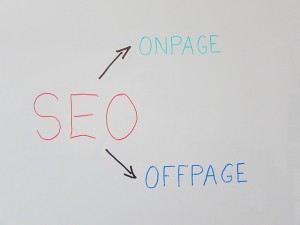 When thinking about SEO, it’s tempting to concentrate on what’s occurring behind-the-scenes and neglect better ways to increase exposure. Whether you’re directly dealing with SEO or looking to compliment your existing SEO presence with tactics for additional exposure, it’s important to continually focus on developing and growing your digital marketing strategy.
When thinking about SEO, it’s tempting to concentrate on what’s occurring behind-the-scenes and neglect better ways to increase exposure. Whether you’re directly dealing with SEO or looking to compliment your existing SEO presence with tactics for additional exposure, it’s important to continually focus on developing and growing your digital marketing strategy.
On-Page vs. Off-Page SEO Factors
When you look at SEO, it’s important to understand the difference between on-page and off-page factors. While these two groups work together for the greater good of increasing rankings and driving traffic, they’re unique ventures. According to this handy infographic that divides SEO success factors into a periodic table design, on-page elements refer to content, HTML, and site architecture, while off-page elements include links, trust, social, and personal.
On-page factors. When the average marketer or amateur thinks about SEO, things like keywords, HTML structure, meta descriptions, headlines, site speed, and crawlability come to mind. These are the on-page factors and are very important; however, you can’t forget about off-page elements.
Off-page factors. These are largely related to brand awareness and exposure and include things like backlinks, site and brand authority, social reputation and shares, and geographical location.
Being successful at SEO and maximizing exposure requires you to pay attention to both sets of factors.
7 Ways to Boost and Enhance SEO Efforts
With the goal of enhancing brand awareness and SEO prowess in mind, let’s take a look at some of the best SEO-boosting tips to pursue:
1. Produce high-level content. The number one tip is obviously to produce high-level content. What that means is writing content that satisfies both human readers and the search engines. When you’re able to do this, you can affect both on-page elements like content quality and keyword relevancy, as well as enhance off-page elements like authority, trust, and identity. While you never want to let keywords dictate your entire content strategy, it can be helpful to start with a group of relevant terms and use those niches as launching points for more in-depth content.
2. Craft sleek landing pages. If you’re not tapping into the power of custom landing pages, you’re missing out. They provide a great opportunity for driving targeted traffic to your website and building trust with a specific audience. Thanks to user-friendly tools and plugins, even those with little design experience can craft sleek, high-converting pages. The goal for landing pages is to keep the message brief, while using relevant content and interactive elements to engage with readers.
3. Earn quality links. Authoritative backlinks have always been an important off-page factor for SEO. While purchasing links can lead you down a slippery slope, investing in highly relevant guest blogging opportunities and industry partnerships can allow you to enhance brand awareness and increase exposure over an extended period of time. In addition to guest blogging, there are plenty of other ways to earn backlinks. These include joining and participating in blogging communities, answering questions in message boards and social communities, linking to your blog in forum signatures, commenting on other blogs in order to build a reputation or enhance thought leadership, and more.
4. Target long-tail search queries. The competitive nature of SEO and Google’s affinity towards semantic search means long-tail keywords are more important than ever. Instead of focusing on basic two or three word search queries, identify very specific four, five, or six-plus word terms. Not only will this help you enhance your rankings, but it also attracts more relevant traffic.
5. Prepare for mobile audiences. It’s no surprise that local mobile traffic will become increasingly important in the coming months and years. This point is further solidified by Google’s recent focus on rewarding mobile-friendly sites in the search results. In order to satisfy the demands of varying devices, the best SEO investment you can make is transitioning to responsive design.
6. Invest in rigorous A/B testing. The only way to truly know if your on-page SEO strategies are working is to invest in A/B testing. In fact, you should rigorously approach A/B testing and begin analyzing anything and everything you can get your hands on. With dozens of feature-rich, cost-effective testing software solutions available, there’s no reason not to.
7. Build a loyal social following. Anyone who tells you social media and SEO are completely independent isn’t telling you the truth. Social networks like LinkedIn, Facebook, Twitter, and Pinterest help you enhance awareness, attract valuable backlinks, increase shares, and grow trust. In fact, it’s arguably one of the most important off-page factors.
Developing a Balanced Strategy
Whether you’re looking to attract more leads, increase conversions, boost search rankings or enhance overall brand awareness, these seven tips can get you closer to where you need to be. As you move forward in 2015 and beyond, focus on a balanced approach that keeps both on-page and off-page factors in mind.
Author: Larissa Ellicot
Courtesy: www.searchenginepeople.com
Leave a Reply
You must be logged in to post a comment.